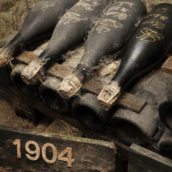 Valentine’s Day is not far away, and if you haven’t picked a romantic gift yet, don’t worry. Champagne is one of the safest options – I’ve never met anyone who doesn’t appreciate a glass of good fizz – and we have a great selection.
Valentine’s Day is not far away, and if you haven’t picked a romantic gift yet, don’t worry. Champagne is one of the safest options – I’ve never met anyone who doesn’t appreciate a glass of good fizz – and we have a great selection.
We’ll be covering the world of Champagne in more detail on the blog this year, with in-depth guides covering how Champagne is made, which foods to serve with it and much more – let us know if there’s anything in particular you want to know. In the meantime, take a look at our top tips below and Happy Valentine’s Day!
Top 10 Champagnes for Valentine’s Day
- Bruno Paillard Vintage Assemblage 2008 Brut – an amazing producer whose passion for Champagne translates into the wines that are incredibly intense in style
- Veuve Clicquot Rich – a sweeter expression from the house of Clicquot designed to be drunk on the rocks – or serve it with strawberries and cream
- Marguet Pere & Fils Blanc de Noirs Extra Brut – made with 100% Pinot Noir, making it a great Champagne to pair with oysters
- Laherte Freres Brut Ultradition – one of the best value-for-money Champagnes out there
- Gosset Grande Reserve Brut – our winner of the Champagne of the Year, this is an elegant cuvée that is the perfect aperitif
- Pol Roger Reserve NV – a classic wine from a classic house – raise a glass with a starter of smoked salmon
- Perrier-Jouët Blason Rosé – a pretty rosé that pairs wonderfully with baked lobster
- Moët & Chandon Ice Imperial – an off-dry Champagne that will finish the evening with a bang
- Laurent-Perrier Rosé NV – for the traditionalist; a rosé that will be instantly recognised
- Billecart-Salmon Brut Rosé NV – a delicate rosé that will put a smile on that special someone’s face.
HOW TO DRINK CHAMPAGNE
Champagne can be aged for a long time, especially certain vintage Champagnes, many of which can be kept for decades. Non Vintage brut styles are often best drunk within three years of purchase, but some can be aged for longer. If you are not sure when to drink your bubbles consult the experts – there is often advice online on when to drink different vintages. If you are storing Champagne make sure you keep it flat, in a cool, dark area.
HOW TO SERVE CHAMPAGNE
It might sound obvious, but Champagne tastes best when it’s chilled. However, overchilling anything is never a good idea as it masks flavours, so we’d recommend taking good Champagne out of the fridge half-an-hour or so before you intend to drink it. In fact, as the Champagne warms up gradually, you’re likely to notice that your second glass will ‘open up’ and have much more flavour than the first.
When it comes to glasses there are two schools of thought. The traditional Champagne glass is the flute: a tall, narrow glass designed to prevent bubbles from escaping, and keeping your fizz fizzy for as long as possible but often are not wide enough to get enough of the aroma.
The other option is the coupe a wider, flatter design, and not, as the popular tale goes, modelled on the shape of Marie Antoinette’s breast. The coupe’s shape is not effective in trapping bubbles; it is too wide to allow you to fully appreciate the aromas of the Champagne, so for me is not a good option. More and more restaurants and serving Champage in wine glasses as it gives you the best of both worlds – keeping the bubbles in and allowing the wine to breathe, therefore maximising the aromas.
Tagged Billecart-Salmon, Bruno Paillard, Gosset, Laherte, Laurent-Perrier, Marguet, Moet, Perrier-Jouet, Pol Roger, Veuve Clicquot










 Enjoy responsibly
Enjoy responsibly
Recent Comments
Unfortunately, the answer is 'between 400g and 2000g per litre' :)
Posted on: 9 October 2024
What ratio of Sloe to gin is used, I see anything from 400 to 2000g of sloe to 1 litre of gin!
Posted on: 7 October 2024
What really makes Bob Harris' predicament in 'Lost In Translation' so absurdly funny is that he nailed it in one take, and the director just couldn't accept that.
Posted on: 11 January 2024